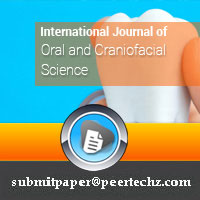International Journal of Oral and Craniofacial Science
Early management of the Acute Closed Lock of the Temporomandibular Joint
Yusuf Emes1* and Buket Aybar2
2Professor Istanbul University faculty of Dentistry Department of Oral & Maxillofacial Surgery, Turkey
Cite this as
Emes Y, Aybar B (2017) Early management of the Acute Closed Lock of the Temporomandibular Joint. Int J Oral Craniofac Sci 3(1): 012-013. DOI: 10.17352/2455-4634.000025Opinion
Disc displacement without reduction (DDwoR), which is common among the temporomandibular disorders (TMD’s) may be difficult to deal with by the clinician.
The term closed lock usually refers to the condition of DDwoR and manifest itself with painful limited mouth opening [1], and may sometimes be difficult to differentiate from other clinical entities such as spasm of the lateral pterygoid muscle or anchored disc phenomenon [2], It is generally considered that intervening in the early stages of the closed lock leads to a better prognosis.
However, the term acute closed lock is still a matter of debate. Closed lock lasting less than one week is generally considered to be acute [3], but some researchers have extended this period up to 4 weeks [4]. Two thirds of the patients with closed lock tend to improve over time. However, this means that one third of them don’t or even worsen over time [2], therefore, that the clinician has to attempt to correct this disorder as soon as possible.
The simplest and the most conservative method in the management of acute closed lock is manual unlocking. This is usually done under local anesthesia and commonly followed by the fabrication of anterior repositioning splint after the repositioning [2].
Recently, we have been able to recapture the disc in two patients who have reported a closed lock of about three weeks. The diagnosis was made clinically, in which the patients presented with an acute decrease in mouth opening accompanying a hard end feel, without any signs of infection or major trauma. Their anamneses revealed a previous temporomandibular joint (TMJ) clicking which disappeared on locking. Panoramic radiographs were taken in order to exclude major pathologies, but the patients were not referred for a Magnetic resonance imaging (MRI) because we did not want to postpone the intervention. Manipulations were done only by the anesthesia of the temporomandibular joint capsule. The mandible was held on the affected side with the thumb on the molar teeth. Then the condyle was manipulated inferiorly and anteriorly in order to recapture the anteriorly displaced disc. The mouth opening returned to its normal range and deviation on opening disappeared as the disc returned to its normal position. Due to relief in mouth opening and lack of pain, radiological confirmation of disc reposition was not required. Our clinical protocol on temporomandibular disorders requires advanced radiocraphic techniques such as MRI only when an invasive procedure is planned. One patient dropped out due to refusing to wear the anterior repositioning splint during daytime, but the other was successfully managed. The other patient is still under follow up without any relapse.
We suggest that clinicians can try to recapture the temporomandibular joint disc in relevantly “late” cases (up to 4 weeks as classified early by Yoshida et. al.) [4], which still can be successful in preventing the progress of DDwoR into much degenerative disorders. If the unlocking is not successful, than the clinician can go on with splints or can retry unlocking following artrocenthesis which is recommended by some authors for the management of TMJ osteoarthritis [5,6].
- Okeson JP (2012) Management of Temporomandibular Joint Disorders. In: Okeson JP, ed. Management of. temporomandibular disorders and occlusion. MO: Mosby, Elsevier Inc. 7th ed: 325-329. Link: https://goo.gl/E2afoL
- Al-Baghdadi M, Durham J, Steele J (2014) Timing interventions in relation to temporomandibular joint closed lockduration: a systematic review of 'locking duration'. J Oral Rehabil. 41: 24-58. Link: https://goo.gl/WSK9XW
- Klasser GD, Epstein JB (2014) How to manage "closed lock" disc displacement without reduction with limited opening.J Can Dent Assoc 80: e60. Link: https://goo.gl/fdftvz
- Yoshida H, Sakata T, Hayashi T, Shirao K, Oshiro N, et al. (2011) Evaluation of mandibular condylar movement exercise for patients with internal derangement of the temporomandibular joint on initial presentation. Br J Oral Maxillofac Surg. 49: 310- 313. Link: https://goo.gl/MzLXjW
- Guarda-Nardini L, Stifano M, Brombin C, Salmaso L, Manfredini D (2007) A one-year case series of arthrocentesis with hyaluronic acid injections for temporomandibular joint osteoarthritis. Oral Surg Oral Med Oral Pathol Oral Radiol Endod 103: 14-22. Link: https://goo.gl/wqVHkF
- Manfredini D, Bonini S, Arboretti R, Guarda Nardini L (2009) Temporomandibular joint osteoarthritis: an open label trial of 76 patients treated with arthrocentesis plus hyaluronic acid injections. Int J Oral Maxillofac Surg 38: 827-834. Link: https://goo.gl/WDsYn4
Article Alerts
Subscribe to our articles alerts and stay tuned.
 This work is licensed under a Creative Commons Attribution 4.0 International License.
This work is licensed under a Creative Commons Attribution 4.0 International License.

 Save to Mendeley
Save to Mendeley
